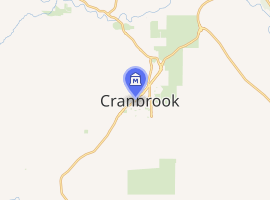Canadian Museum of Rail Travel
The Canadian Museum of Rail Travel, or its brand name "Trains Deluxe", is located in Cranbrook, British Columbia, Canada, a city of about 25,000 on the west side of the Rocky Mountains. The city was developed by the arrival of the Canadian Pacific Railway (CPR) in 1898, as the administrative centre for the railway's "Crowsnest Pass" route. It is still a busy railway centre with Canadian and international freight traffic. Cranbrook was incorporated as a city in 1905 when Cranbrook boomed into the major economic, and commercial centre of the Kootenays.

| |
| Established | 1977 |
|---|---|
| Location | Cranbrook, British Columbia, Canada |
| Website | www.trainsdeluxe.com |
History
The museum, opened in 1977, restores and displays vintage passenger trains - the transcontinental "Deluxe Hotels-On-Wheels". It emphasizes deluxe railway passenger cars design in various eras (1886, 1907, 1929, 1936) as well as deluxe railway hotel architecture. The museum is an outgrowth of the Cranbrook Archives, Museum and Landmark Foundation, founded in 1976 with the initial goal of converting an out of service rail car into a local art gallery. The group then discovered that they had unknowingly purchased a dining car from the short-lived Trans-Canada Limited luxury rail line (1929-1931), and the focus of the project shifted to more extensive rail rehabilitation efforts. Founder Garry Anderson was awarded the Order of Canada in 2007 for his efforts in developing the museum.[1]
Collections
The collections include:
- the "Pacific Express" (1886) (two original cars),
- the "Soo-Spokane Train Deluxe" (1907) (four original cars). The cars in this set include a compartment-observation-buffet-library car, a palace sleeper, and a first class day car. The fourth car is a baggage car.
- the "Trans-Canada Limited" (1929) (a complete restored 7-car set). Recipient of Heritage Canada's "Achievement Award" for restoration in 1993. The cars in this set include a crew baggage car, a day parlour car, a dining car, three first class sleepers, and a Solarium-Lounge car.
- the "Chinook" (1936) (a complete four-car set)
- cars that expand the story line including Royal and Business cars.
- the "Royal Alexandra Hall" (1906) the restored former Grand Cafe of the luxurious Royal Alexandra Hotel, Winnipeg, built by the CPR in 1906, but demolished in 1971, with the Museum obtaining the contents in 1999 and opening the Hall in 2004. Recipient of Heritage Canada's "Achievement Award" for restoration in 2007.[2] It can hold up to 184 for formal diner, 280 for concert, and 400 for stand up receptions. There are adjacent facilities that expand the use of this Hall, and which cater to groups of visitors that tour the historic trains.
Instead of the usual mechanical and technological focus that most railway museums employ, the museum emphasizes the social aspects of the railway through travel and design.
It located downtown next to the busy rail yards of the CPR, on Highway 3/95, a major east-west Canadian arterial highway, and a major north-south route linking Banff and Japser National Parks with the Pacific North-West of the USA. Cranbrook is about 50 miles (80 km) north of the Idaho and Montana border with Canada and British Columbia.
The back of the Museum has a siding track for excursion trains arrival, with doors into the Museum's large entrance hall from this track. The spectacular "Royal Canadian Pacific" (a high-end excursion train operated by the CPR on a circle route through the Rockies, out of Calgary, Alberta), uses this facility, as well as occasional special excursions of the CPR's famed #2816 restored "Hudson" style steam locomotive.
A 1992 study about the historical significance of the collections was recently updated by the author, Rober Turner, Curator Emeritus of the Royal British Columbia Museum, in which he states that "the museum is unparalleled anywhere in Canada, and is clearly of national as well as international importance".
References
- Doug Pyper, "Small city claims big trains: historic dining hall adds lustre to rail museum", The Beaver, February 1, 2010.
- "Royal Alex Hotel Lives on in Cranbrook, BC", Manitoba History, September 22, 2016.